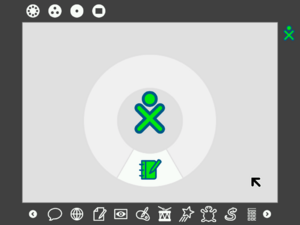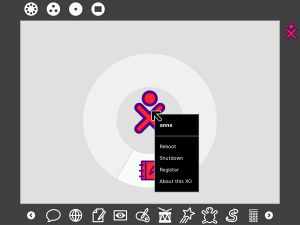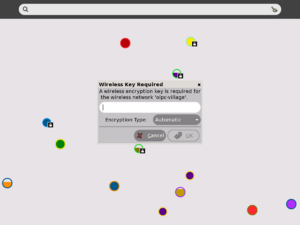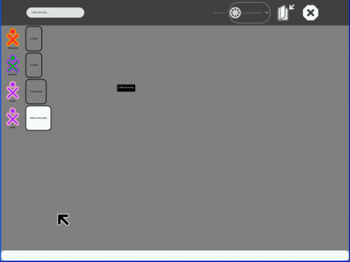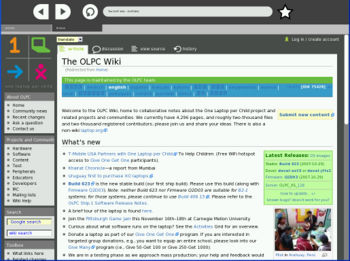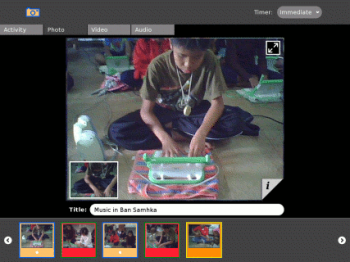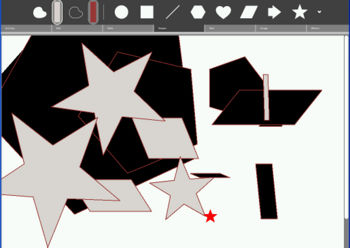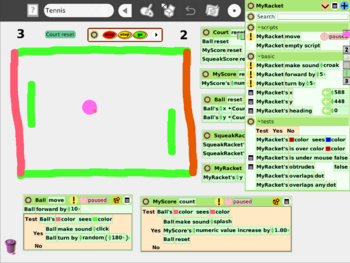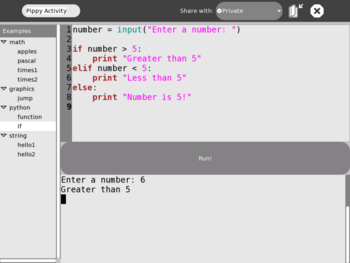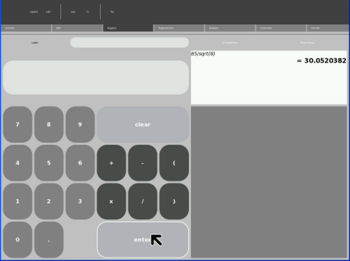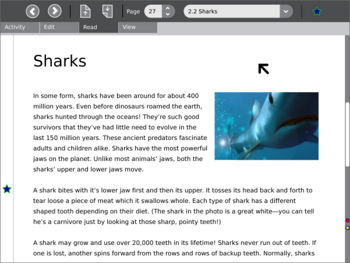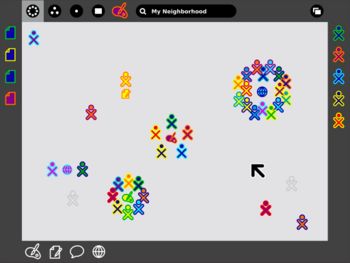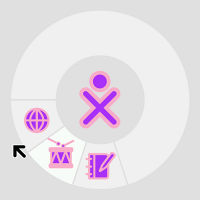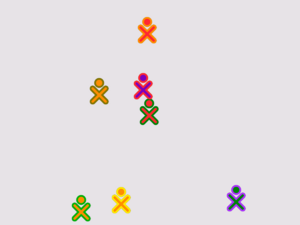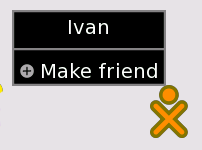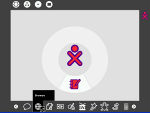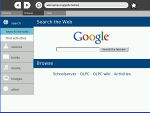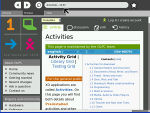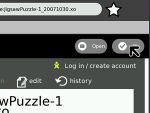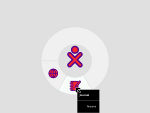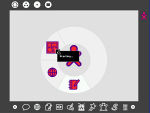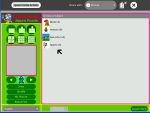Simplified user guide: Difference between revisions
Annegentle (talk | contribs) |
m (don't link to other obsolete documents) |
||
| (107 intermediate revisions by 25 users not shown) | |||
| Line 1: | Line 1: | ||
{{Deprecated |See [[Manuals]]}} |
|||
{{Translations}} |
|||
<small>[[Documentation#Simplified_User_Guide|Documentation]] > Simplified User Guide</small> |
|||
''see also : [[Demo notes/542]] and [[Demo notes/608]]'' |
|||
==By the Community, For the Community: Introducing the XO== |
==By the Community, For the Community: Introducing the XO== |
||
The XO is designed to help you, your family, and your community to learn and grow |
The XO laptop is designed to help you, your family, and your community to learn and grow, and to help you expand your knowledge and to have fun. The XO can help you make new friends in your own area or across the world. When you make friends by communicating with the XO you become part of a community of people around the world. A community contributed to the project that made this computer and everything on it, and you use it within a community. |
||
Community projects like one that makes the XO are successful because they are helpful. Community projects are helpful because of all the people who add or improve something. Any way you can help to add or improve something on the XO would be very helpful. |
|||
Like any community effort, the XO has great things about it, and it also can be improved. Ideas and feedback are one of the greatest gifts that you can give to the XO development project. You do not need to be an expert; you just need to be willing to share your thoughts. Know that the community would be glad to hear them. |
|||
An important thing to remember is that there is only one serious mistake you can make on the XO laptop: thinking that your contribution would not be helpful. |
|||
Like any community effort, the XO laptop has great things about it, and it also has room for improvement. Ideas and feedback are one of the greatest gifts that you can give. You don't need to be an expert, you just need to be willing to share your thoughts. Know that the community would be glad to hear them. |
|||
We hope that the XO |
We hope that the XO is helpful, that you enjoy and learn from it. Our utmost hope is that someday you will join us in making it better. |
||
All are welcome. |
All are welcome. |
||
==About computers == |
==About computers == |
||
Your XO is a laptop computer. |
Your XO is a laptop computer. |
||
'''What is a computer?''' |
'''What is a computer?''' |
||
A computer is a tool, a classroom, a toy, |
A computer is a tool, a classroom, a toy, a way to communicate with others. A computer can be whatever you want it to be. Many people use computers to write, to perform mathematics, to create art, to play games, to record sound and images, to communicate with others, to read, and to learn. The uses of the XO is only limited by your own imagination. |
||
'''What can |
'''What can your XO do?''' |
||
Your XO can store written stories, videos, pictures |
Your XO can store an entire library of written stories, videos, and pictures. It can make and play music. It contains Activities that you can use to learn math, play games, create pictures, and communicate with others. You interact with your XO using the touchpad, keyboard, microphone, or camera. |
||
'''How does it do it?''' |
'''How does it do it?''' |
||
Computers are built of component parts that work together to carry out tasks that you give to the computer by interacting with it. You can use your XO to figure out how computers work by reading about computers and learning the basics, and then learning about hardware and software and how it all works. |
|||
==Opening the XO == |
==Opening the XO == |
||
[[Image:How-to-open.gif|thumb|100px|right| |
[[Image:How-to-open.gif|thumb|100px|right|Animation showing how to open the XO.]] |
||
[[Image:OpenA4.svg|thumb|100px|right| |
[[Image:OpenA4.svg|thumb|100px|right|Line drawings showing how to open the XO.]] |
||
Physically you can open, flip, and close the XO to position it in different ways. |
Physically you can open, flip, and close the XO to position it in different ways. |
||
| Line 38: | Line 32: | ||
<gallery caption="To open"> |
<gallery caption="To open"> |
||
Image:Opening-1.jpg|For handheld mode, lift the "bunny ears." |
Image:Opening-1.jpg|1. For handheld mode, lift the "bunny ears." |
||
Image:Opening-2.jpg|Listen for the laptop clicking open. |
Image:Opening-2.jpg|2. Listen for the laptop clicking open. |
||
</gallery> |
</gallery> |
||
[[Image:How-to-flip.gif|thumb|100px|right|How to switch screen positions.]] |
[[Image:How-to-flip.gif|thumb|100px|right|How to switch screen positions.]] |
||
<gallery caption="To flip"> |
<gallery caption="To flip"> |
||
Image:Rotate-1.jpg|Bring the display up to a 90-degree angle and put the antennae down. |
Image:Rotate-1.jpg|1. Bring the display up to a 90-degree angle and put the antennae down. |
||
Image:Rotate-2.jpg|Rotate the display 180 degrees until it is facing backwards. |
Image:Rotate-2.jpg|2. Rotate the display 180 degrees until it is facing backwards. |
||
Image:Rotate-3.jpg|Lay the display down onto the keyboard. |
Image:Rotate-3.jpg|3. Lay the display down onto the keyboard. |
||
Image:Rotate-4.jpg|Enjoy the XO in this mode! |
Image:Rotate-4.jpg|4. Enjoy the XO in this mode! |
||
</gallery> |
</gallery> |
||
==Starting and |
==Starting and shutting down the XO == |
||
===Starting=== |
|||
When you press the Power button, the XO starts up after about two minutes, and then asks your name. |
|||
When you press the power button for the first time, the XO starts up after about two minutes, and then asks your name. The next time you start it, it will remember your name and go directly to the Home screen. |
|||
<gallery caption="To start up"> |
<gallery caption="To start up"> |
||
Image:Simple_Manual_01_Entering_Name.png|Enter your name |
Image:Simple_Manual_01_Entering_Name.png|1. Enter your name. |
||
Image:Simple_Manual_02_Entered_Name.png| |
Image:Simple_Manual_02_Entered_Name.png|2. Once you enter your name, click Done. |
||
Image:Simple_Manual_03_Choosing_Color.png|Choose your |
Image:Simple_Manual_03_Choosing_Color.png|3. Choose your colors by clicking repeatedly. |
||
Image:Simple_Manual_04_Chose_Color.png| |
Image:Simple_Manual_04_Chose_Color.png|4. Once you've chosen your colors, click Done. |
||
Image:Simple_Manual_05_Home.png|Ready to begin |
|||
</gallery> |
</gallery> |
||
[[Image:Simple_Manual_05_Home.png|thumb|left|Your screen looks like this when the laptop is ready to begin.]] |
|||
Next, look at your XO camera (small round dot on the right next to the screen) while it takes your picture. |
|||
<br style="clear: both;"> |
|||
===Shutting down=== |
|||
When you're done using the computer, go to the Home view, and then hover the pointer over the middle XO icon until you see a menu. Next, choose to Reboot or Shutdown to ensure your laptop stops properly. |
|||
When you're done using the computer, go to the Home view, and then hover the pointer over the middle XO icon until you see a menu. Next, choose to Shutdown to ensure your laptop stops properly. |
|||
[[Image:Rebootshutdown.jpg|thumb|left|The Reboot and Shutdown options appear when you hover your mouse over the XO icon in the Home view.]] |
|||
<br clear="all" /> |
|||
You can also shut down by pressing and holding the power button for a few seconds, but it's better for the computer to shut down from the Home view. Be careful that your power button does not get "stuck" in the down position. |
|||
==Connecting your XO to the network == |
==Connecting your XO to the network == |
||
Thanks to network connections, you can use your XO to explore distant places while you stay at home. |
|||
[[image:542-mesh-meshicon.png|thumb|right|Mesh Icon]] |
|||
Your XO connects to and works with with other XOs. To get a wireless network connection, follow these steps: |
|||
Thanks to network connections, you and your XO are going places while staying close to home. |
|||
# Press fn 1 or the Neighborhood button at the top of the keyboard to go to the Neighborhood View. |
|||
Your XO connects to networks and other computers. The XO can take up to five minutes to find network connections. While it's searching, the inside of a colored circle or triangle icon blinks. You might need to ask your teacher for help, if your XO asks you to enter an access key. |
|||
# Roll the pointer over one of the network access circles until you recognize the name of the wireless network. A circle with a lock icon requires a wireless key (a password.) |
|||
# To connect, click a network access circle, and enter the wireless key if prompted. You might need to ask your teacher or parent for the wireless key.[[Image:Screenshot Wifi Key Popup.png|thumb|left|Wireless key requested]] |
|||
While the XO is connecting to the network, the access point blinks. A white outline indicates that your XO is connected. To disconnect from the network, hover the pointer over the access point and click Disconnect on the menu.Once your XO is connected, you can use the Browse Activity to access the Internet. |
|||
While your XO remains connected, the outline of the icon blinks. |
|||
If you cannot see an access point with a name that you recognize, the wireless network might be hidden. For more information or if you have difficulties getting a network connection, refer to to [[Wifi_Troubleshooting_Guide]] or [[Wifi_Connectivity]]. |
|||
More information about your XO's connection: |
|||
* If you connect to a wireless network, your laptop becomes a network point; other XO laptops within 100 meters can connect to the Internet through your XO laptop. |
|||
More information about your XO's connection: |
|||
* Similarly, if there is another XO connected to the Internet nearby, you can connect to that XO laptop—and the Internet—through the other XO. |
|||
* If there are no Internet network points available after five minutes of searching, your XO laptop defaults to Channel 1, which enables your XO laptop to connect to other XO laptops. |
|||
* Your wireless access point has a network name, also called an SSID, that displays in the Neighborhood View. The XO cannot recognize network names that contain spaces. |
|||
* When you connect the XO to a wireless network, the XO becomes a network point; other XO laptops within about 100 meters can connect to the Internet through your XO laptop. |
|||
* Similarly, if a nearby XO is connected to the Internet, you can connect to that XO laptop and the Internet through the other XO when using the mesh network. |
|||
* With the Give 1 Get 1 (G1G1) release, if you are connected to the Internet, your XO laptop cannot be on the mesh network, and if your XO is on a mesh network, it cannot simultaneously connect wirelessly to the Internet. |
|||
* If the XO cannot find an available Internet network point after five minutes of searching, it defaults to Mesh Network 1, which enables your XO laptop to connect to other nearby XO laptops. |
|||
* Please be patient; it can take your XO up to five minutes to find a good connection. |
* Please be patient; it can take your XO up to five minutes to find a good connection. |
||
'''Related links''' |
|||
* [[Wifi Connectivity]] |
|||
* [[WPA manual setting]] |
|||
==Cleaning and caring for your XO == |
==Cleaning and caring for your XO == |
||
While your XO is tough, you should try to keep your XO dry and clean and avoid dropping it or stepping or sitting on it. If it gets dirty, wipe it with a damp cloth and dry it. It can survive an occasional accidental soaking in a rain storm, but don't dip it all the way into water. |
While your XO is tough, you should try to keep your XO dry and clean and avoid dropping it or stepping or sitting on it. If it gets dirty, wipe it with a damp cloth and dry it. It can survive an occasional accidental soaking in a rain storm, but don't dip it all the way into water. |
||
The XO laptop has no hard drive to crash and only two internal cables, so it is less likely to fail than other laptops. For added robustness, the XO's plastic walls are thicker than the standards for other laptops. Its green mesh network antennas, or "bunny ears," |
The XO laptop has no hard drive to crash and only two internal cables, so it is less likely to fail than other laptops. For added robustness, the XO's plastic walls are thicker than the standards for other laptops. Its green mesh network antennas, or "bunny ears," double as external covers for the USB ports, which are protected internally as well. Internal bumpers protect the screen display by offering cushioning. |
||
==Updating and maintaining your XO == |
|||
You might want to update all the software on your XO laptop when a new version of the software is released. It takes about 30 minutes, and you can use the following instructions to install all new updates without losing any data. Refer to wiki.laptop.org for the most recent version number and for information about updates and reasons for updating. For example, the version that shipped on early Give 1 Get 1 XOs was 650 but it did not support certain wireless settings, so you could use this procedure to update to version 656. |
|||
To determine what version your XO currently contains, go to the Journal, and then press ctrl + alt + the Group View key (three dots) simultaneously from your Journal. In the output, look for the number after the word build. This example shows build 653: |
|||
<blockquote> |
|||
OLPC build 653[/B] (stream ship.2; variant devel_jffs2) |
|||
Kernel 2.6.22-20071121.7.olpc.af3dd731d18bc39 on an i586 |
|||
xo-0D-39-78 Login: To return to the Home View, press ctrl + alt + the Home View keys simultaneously. |
|||
</blockquote> |
|||
#Plug the AC adapter into your XO and plug the adapter into an electrical outlet for constant power. |
|||
#Connect to the Internet by going to the Neighborhood View if necessary. If you cannot connect to the Internet, see the Tips section below. |
|||
#Open the Terminal Activity. |
|||
<blockquote> |
|||
terminalactivity |
|||
</blockquote> |
|||
#Log in as root by typing su - l (lower case L, not the number one) and then press enter. |
|||
<blockquote> |
|||
su -l |
|||
</blockquote> |
|||
#Next, in the Terminal Activity, type: |
|||
<blockquote> |
|||
olpc-update -rv <''version-number''><br> |
|||
''ex.:'' olpc-update -rv 653 |
|||
</blockquote> |
|||
#When the process is complete, the XO restarts and the update is complete. |
|||
Tips |
|||
*If you cannot connect to the Internet with your XO, you can still update by connecting to the Internet from another computer and downloading the latest image from http://wiki.laptop.org/go/OS_images. Copy the image files to your USB device. Insert your USB device into your XO. Launch the Terminal Activity and type: |
|||
<blockquote> |
|||
olpc-update --usb |
|||
</blockquote> |
|||
*If your new software does not seem to work correctly, you can revert to the older version by holding down the O key on the game pad (between the right speaker and the power button) when you next turn on the XO. |
|||
*If you are upgrading because you have a version that does not support WiFi Protected Access (WPA) but that is your home Internet connection, you might want to access public wireless to connect to the Internet for an online upgrade, such as at a T-Mobile hotspot or a local libary. |
|||
*This process may take more than 30 minutes. |
|||
*As of build 703, which should be available in April 2008, you must install Activities separately from the Sugar operating system. If you update to build 703, refer to the Release Notes on wiki.laptop.org for more information: [[OLPC_Update.1_Software_Release_Notes|Update.1 release notes]]. |
|||
'''Maintenance updates to the XO software''' |
|||
Periodically, such as every month or so, you can update the XO's system files without doing a complete update as described above. |
|||
#Connect to the Internet. |
|||
#Open the Terminal Activity. |
|||
#Log in as a root super user by typing: |
|||
<blockquote> |
|||
su -l |
|||
</blockquote> |
|||
and then press enter. |
|||
#Run a yum update by typing |
|||
<blockquote> |
|||
yum - y update |
|||
</blockquote> |
|||
and then press enter. |
|||
#Exit being logged in as super user by typing |
|||
<blockquote> |
|||
exit |
|||
</blockquote> |
|||
and then press enter. |
|||
#Click Stop in the Terminal Activity to stop the Terminal Activity and return to the Home View. |
|||
==Personalizing your XO == |
==Personalizing your XO == |
||
When you start your XO, you'll see a small O on top of an X. This symbol represents you when you use your XO. Click this person symbol to choose colors that |
When you start your XO, you'll see a small O on top of an X. This symbol represents you when you use your XO. Click this person symbol to choose colors that you like best. |
||
After the initial startup, you can change the name, colors, language, time zone, and other settings of your XO by using sugar-control-panel commands in the [[Terminal Activity]]. Sugar is the operating system for the XO. It organizes the systems that run the clock, activates the Activities, and store the Journal entries. The Terminal Activity runs text-based commands for your XO instead of the Sugar graphical commands. |
|||
=== To change the name of your XO === |
|||
# Start the Terminal Activity by clicking the Terminal Activity icon from the Home view. |
|||
# To change the name of the XO, click next to the prompt and then type the following command: |
|||
sugar-control-panel -s nick ''newname'' |
|||
where the newname is the name you want for your XO. |
|||
# Press enter to run the command, and then press ctrl+alt+erase to restart Sugar. |
|||
=== To change the colors of your XO icon === |
|||
# Start the Terminal Activity by clicking the Terminal Activity icon from the Home view. |
|||
# Select your colors from the table of XO icon images at [[Media:Buddy-Icon-Color-Matrix.pdf]]. |
|||
# Type the following command to change the colors: |
|||
sugar-control-panel -s color outlinecolor fillcolor outlineshading fillshading |
|||
# Press enter to run the command, and then press ctrl+alt+erase to restart Sugar. The XO's new color selections appear when you restart. |
|||
The available outline and fill colors are: |
|||
* red |
|||
* orange |
|||
* yellow |
|||
* green |
|||
* blue |
|||
* purple |
|||
The available shading settings are: |
|||
* dark |
|||
* medium |
|||
* light |
|||
Tips |
|||
* Refer to [[Sugar_Control_Panel]] for a continually updated list of, and reference information about, the command options (such as a list of available language settings). |
|||
* Type " sugar-control-panel -h language " to get a list of all the available language settings. |
|||
* Complete view of possible colors are also available via [[XO_colors]]. |
|||
==Avoiding loss of your XO == |
==Avoiding loss of your XO == |
||
Although your XO handle is sturdy enough for you to carry your XO by itself, you may want to put your XO in a bag with a shoulder strap for easier carrying. When you first start the XO, if a school server is available, it registers with your school's server to give you additional storage for pictures or stories that you make. Also, to ensure that no one other than you can use your XO, the XO sends a security code that lets officials track down your XO if needed. |
Although your XO handle is sturdy enough for you to carry your XO by itself, you may want to put your XO in a bag with a shoulder strap for easier carrying. When you first start the XO, if a school server is available, it registers with your school's server to give you additional storage for pictures or stories that you make. Also, to ensure that no one other than you can use your XO, the XO sends a security code that lets officials track down your XO if needed. |
||
==Copying the XO contents (backing up)== |
|||
Your XO will automatically copy items from the Journal to your school server, which provides a way to "back up" your information. This "back up" process means that if you ever lost a song or image or story that you wrote, you can get it back (recover it) from your school server and put it on your XO laptop. If you think you have lost something, ask your teacher to run the backup-restore command. |
|||
If you needed to replace your XO laptop with a new one for some reason, then your teacher can follow these instructions for copying all of your songs or stories or other files. |
|||
# (optional) Insert teacher USB key into laptop, which identifies the administrator for the school server. If a teacher USB key is present, you do not have to enter a password for the restore command. |
|||
# Press Ctrl Alt F2, also called the world view key. |
|||
# Log in using the root username and password. |
|||
# At the command line, type |
|||
identity-restore "nickname" |
|||
# If teacher USB key isn't present, you must enter the password for the xoreg user on the school server. |
|||
# Return to the Sugar console by pressing Ctrl Alt F4, also called the application view key. |
|||
==Keeping information in the Journal== |
|||
Also, in the Journal, you can click the Backup tab and if your laptop is registered to a school server, the XO laptop copies your files to the school server. |
|||
Use the Journal to view a collection of all your past Activities on the laptop. To open the Journal, click the notebook-and-pencil Journal icon at the bottom of the Activity Circle on the Home View... or press the magnifying-glass key near the top left corner of the keyboard. |
|||
Each time you use an activity, the Journal stores a record calling your work by the activity name, such as "Write Activity" or "TurtleArt Activity." (The stored results of an activity session are sometimes called "files.") |
|||
''Related links'' |
|||
[[Trial1 Backup]] |
|||
You can give an activity session a more specific name when you Exit from the activity, or by editing its listing in the Journal. A more specific name might be the name of the person in a Record photo, a title for your latest Draw artwork, or a phrase describing your last Write activity. |
|||
===Keeping information in the Journal=== |
|||
Use the Journal to view a collection of all your Activities on the laptop. Click the Journal icon at the bottom of the Activity Circle on the Home View. From the Journal, you can search by keyword and sort by activity or date. Clicking on an entry brings up a detail page from which you can resume an activity (by clicking on the Activity Icon or Key ) or copy its contents onto the clipboard (by pressing on the Copy Icon ). |
|||
From the Journal, you can search past activities by keyword and sort by activity or date. |
|||
The Journal also supports external media. When you plug a USB key into the XO, the contents from the USB key are entered into the datastore of the XO laptop to access using the Journal. Click on the USB icon to access the content. You can also drag and drop Journal entries on to or off of a USB key. |
|||
Clicking on an entry in the Journal brings up a detail page where you can add or edit a Description of the activity, add keyword "Tags", delete, copy or resume the activity. To resume, click on the square in the top right corner of the screen, then on the activity icon beneath the word "Resume." The other icons on the top of the screen are Copy (to the clipboard), Erase (from the Journal and from the computer's memory), and Go back (to the Journal list). |
|||
The Journal also lets you work with external media. When you plug a USB memory device or SD memory card into the XO, an icon representing the device appears at the bottom of the Journal. Click on the USB icon to see the content. You can also drag and drop Journal entries onto or off of a USB key. |
|||
'''Related links''' |
'''Related links''' |
||
*[[Journal_Activity]] with screen images |
|||
*[[OLPC Trial-2 Software Release Notes#Journal and Datastore]] |
*[[OLPC Trial-2 Software Release Notes#Journal and Datastore]] |
||
*[[Journal]] |
*[[Journal]] |
||
| Line 120: | Line 232: | ||
*[[Journal/Specifications]] |
*[[Journal/Specifications]] |
||
*[[542 Demo Notes#Journal]] |
*[[542 Demo Notes#Journal]] |
||
==Copying the XO contents (backing up)== |
|||
Your XO will automatically copy items from the Journal to your school server, which provides a way to "back up" your information. This "back up" process means that if you ever lost a song or image or story that you wrote, you can get it back (recover it) from your school server and put it on your XO laptop. If you think you have lost something, ask your teacher to run the backup-restore command. |
|||
If you needed to replace your XO laptop with a new one for some reason, then your teacher can follow these instructions for copying all of your songs or stories or other files. |
|||
# (optional) Insert a teacher USB key into laptop, which identifies the administrator for the school server. If a teacher USB key is present, you do not have to enter a password for the restore command. |
|||
# Press Ctrl+Alt+F2 (F2 is also called the Group view key). |
|||
# Log in using the root username and password. |
|||
# At the command line, type |
|||
#*'''identity-restore "nickname"''' |
|||
# If a teacher USB key isn't present, you must enter the password for the xoreg user on the school server. |
|||
# Return to the Sugar console by pressing Ctrl+Alt+F4 (F4 is also called the Activity view key). |
|||
Also, in the Journal, you can click the Backup tab and if your laptop is registered to a school server, the XO laptop will copy your files to the school server. |
|||
''Related links'' |
|||
[[Trial1 Backup]] |
|||
==Conserving disk space== |
==Conserving disk space== |
||
| Line 127: | Line 258: | ||
# Go to the Home view and click the Journal icon. |
# Go to the Home view and click the Journal icon. |
||
# Look for files that you can delete, such as old files or large files that you |
# Look for files that you can delete, such as old files or large files that you have copied to another location. |
||
## In general, video and audio media files and some PDF files or e-books are larger than individual Write activity files or still photographs. |
|||
## The Browse activity may download more than one copy of a PDF or media file if you do not realize you have already downloaded it. Delete duplicates to save space |
|||
# Select a file by clicking on its wide bar. This will give you a preview of the activity or file. If you want to delete it, click the Erase button (minus sign). If you want to resume using it, click on the large box on the right. |
# Select a file by clicking on its wide bar. This will give you a preview of the activity or file. If you want to delete it, click the Erase button (minus sign). If you want to resume using it, click on the large box on the right. |
||
| Line 174: | Line 307: | ||
*[[Battery Charging]] |
*[[Battery Charging]] |
||
==Playing with the XO== |
|||
You can play with your XO laptop while you learn with it. There are plenty of Activities that are fun to play with while learning. |
|||
===EToys=== |
|||
[[Image:EtoysTennis.png|right|350px|thumb|EToys Activity]] |
|||
* To start EToys, from the [[#Frame|Frame]], press the shooting-star icon [[Image:etoysicon.png|40px]]. |
|||
* Paint a picture. |
|||
* Record sounds around you. |
|||
* Share your drawings and pictures with buddies on your network. |
|||
* Design and make a car you would like to learn how to drive. |
|||
* Create objects of different weights and see how gravity works on them. |
|||
<br clear=all> |
|||
==Activities== |
|||
==Sharing and expressing with the XO== |
|||
:''Learning is hard fun.'' —Seymour Papert |
|||
You can play with your XO laptop while you learn with it. There are plenty of Activities that are fun to play with while learning. |
|||
You can use your XO laptop to tell other people about your life, writing stories, taking pictures, writing music, and sharing any of those things with others. You can share by showing someone the screen in person, or you can share by sending files to other people. Your teacher also probably has ideas about how to share and collaborate with your classmates and your family to help you learn from others. |
|||
===[[Chat]]=== |
===[[Chat]]=== |
||
[[Image:Xo_chat_activity.jpg|right|350px|thumb|Chat Activity]] |
[[Image:Xo_chat_activity.jpg|right|350px|thumb|Chat Activity]] |
||
You can use your XO laptop to tell other people about your life, writing stories, taking pictures, writing music, and sharing any of those things with others. You can share by showing someone the screen in person, or you can share by sending files to other people. Your teacher also probably has ideas about how to share and collaborate with your classmates and your family to help you learn from others. |
|||
* To start Chat, click the Chat icon either in the Neighborhood View or in the Activities toolbar [[Image:Chat.png|40px]]. |
* To start Chat, click the Chat icon either in the Neighborhood View or in the Activities toolbar [[Image:Chat.png|40px]]. |
||
* Advertise your Chat by clicking "Share with neighborhood", or invite specific people in the Neighborhood View to join your Chat with "Invite". |
* Advertise your Chat by clicking "Share with neighborhood", or invite specific people in the Neighborhood View to join your Chat with "Invite". |
||
| Line 198: | Line 323: | ||
* You can save the text from a Chat conversation by clicking the Journal (where it says Keep). |
* You can save the text from a Chat conversation by clicking the Journal (where it says Keep). |
||
* If you want to search for a previous conversation, use the Journal. |
* If you want to search for a previous conversation, use the Journal. |
||
<br |
<br style="clear: both;"> |
||
==Learning and Exploring with the XO == |
|||
All over the world, people are at their computers learning, exploring, and thinking of new ideas. Now you're one of those people. |
|||
===Browse |
===[[Browse]]=== |
||
[[Image:browse_olpc.jpg|right|350px|thumb|Browse Activity]] |
[[Image:browse_olpc.jpg|right|350px|thumb|Browse Activity]] |
||
Your XO gives you tools to explore the world from where you sit. When you are connected to the network, you can read web pages from the Internet. |
Your XO gives you tools to explore the world from where you sit. When you are connected to the network, you can read web pages from the Internet. |
||
| Line 212: | Line 333: | ||
* See what's happening in the world with the News Reader. |
* See what's happening in the world with the News Reader. |
||
* Play video and sounds. |
* Play video and sounds. |
||
<br style="clear: both;"> |
|||
=== |
===[[Write]]=== |
||
[[Image: |
[[Image:write_activity.jpg|right|350px|thumb|Write Activity]] |
||
Express yourself. |
|||
Your XO laptop contains a library that offers many interesting reading materials in many languages. These books are sometimes called ebooks for electronic books, and Portable Document Format or PDF files work well. You might like to flip the laptop display so that it lays flat while reading ebooks. |
|||
* Make a diary to record your life experiences. |
|||
# To use the reader, use the Browse Activity to download the .xo file from wiki.laptop.org. |
|||
* Write a poem or one hundred poems. |
|||
# When the .xo file has downloaded, save it to your Journal. |
|||
* Compose a letter for someone you've never met. |
|||
# Go to your Journal, click on the Read.xo file. and click the Resume icon. The Read Activity should now be installed. |
|||
* Describe things you see, or imagine. |
|||
* Create your own world or how you'd like our world to be. |
|||
Name your writing. |
|||
===Measure=== |
|||
*The "Activity" tab lets you name whatever you write. |
|||
[[Image:Measure activity.jpg|right|350px|thumb|Measure Activity]] |
|||
*If you don't name something, it will be called "Write Activity" in the Journal list. |
|||
[[Image:Measure icon.jpg|40px]] A tool for exploring the physical world. |
|||
*You can write many diary entries, letters, poems or other documents. All of their names will show up in the Journal. |
|||
* Measure DC and AC voltages and observing them on a oscilloscope-like interface. |
|||
*A name can summarize or describe what you have written. A name can be made of words or numbers. |
|||
* Watch waveforms in frequency domain (like a spectrum analyzer). |
|||
* |
**In a diary, you might make today's date the name of today's writing. |
||
**If you are writing a letter, you might name it "letter to..." plus the name of the person you are writing to, and maybe the subject of the letter. Example: "to Walter about magical little green computer." |
|||
* With observations about water or bugs or leaves or trees, you can determine patterns and perhaps predictability in the natural world around you. |
|||
**Poems might be named with their first word or two, or you could give them titles. |
|||
<br clear=all> |
|||
*Creating your own world? Give its places and people their own names. |
|||
Explore advanced features. |
|||
===Pippy=== |
|||
* The "Text" tab allows you to change font styles and colors |
|||
[[Image:Pippy.png|right|350px|thumb|Pippy Activity]] |
|||
* Keyboard shortcuts are faster than using the menus -- ctrl-x is cut, ctrl-c is copy, ctrl-v is paste. There are many more. |
|||
[[Image:Pippy-icon.png|40px]] |
|||
* The laptop's cut-and-paste works between activities -- text you copy while using the Browse activity can be pasted into a Write activity page. |
|||
A tool for exploring programming concepts. |
|||
* The "Tables" tab allows you to divide a page into boxes -- a two-box (1x1) table divides the page into two columns; a 7x5 table could be used for a month-long calendar. |
|||
* Use the Pippy Activity to write your own programs using the Python programming language. |
|||
** Try this: Use a table to practice typing or writing... Make a 1x1 table. Using the Browse activity and the ctrl-c (copy) and ctrl-v (paste) keys, paste some practice text into the left box -- maybe a news story or a poem you like. Click in the other box, then practice typing a copy of the the text you pasted. While you type, notice how the original author formed words, phrases and sentences. |
|||
* You can make programs that do calculations, draw, or solve mathematical problems. |
|||
<br clear=all> |
|||
Related pages: [[Write]] |
|||
===Watch and Listen=== |
|||
<br style="clear: both;"> |
|||
===[[Record]]=== |
|||
Watch videos or listen to music with the multimedia player, which supports a variety of audio and video formats. |
|||
[[Image:Record-example.png|right|350px|thumb|Record Activity]] |
|||
Use this activity to record your voice with the built-in microphone, or take pictures or video with the built-in camera. Speak to your XO while recording, and a built-in microphone and stereo speakers let you record and play back your voice or music recordings. With an external microphone and speaker jacks, you can turn your XO into a portable music player or speech recorder. |
|||
* Take a photo by clicking the eye icon. |
|||
* Record sounds by clicking the Record tab, and then clicking Audio. Click the lips icon to start recording your voice or any sounds nearby. |
|||
* Switch to the Journal Activity to see thumbnails representing your pictures or videos or sound recordings. |
|||
; Related links : |
; Related links : |
||
:* [[Educational activity guidelines#Camera]] |
|||
:* [[542 Demo Notes#Watch and Listen]] |
|||
:* [[ |
:* [[Capture]] |
||
:* [[B1-demo-notes#Using the camera]] |
|||
:* [[Helix Media Activity#Helix .22Watch .26 Listen.22 Media Activity]] |
|||
:* [[EAG Additional Features: Microphone and Speakers]] |
|||
<br clear=all> |
|||
:* [[OLPC Human Interface Guidelines/The Sugar Interface#Camera]] |
|||
:* [[OLPC Human Interface Guidelines/The Sugar Interface/Input Systems#Camera]] |
|||
:* [[OLPC Human Interface Guidelines/The Sugar Interface/Input Systems#Microphone and Speakers]] |
|||
:* [[OLPC Human Interface Guidelines/The Sugar Interface#Microphone and Speakers]] |
|||
<br style="clear: both;"> |
|||
=== |
===[[Draw]]=== |
||
[[Image: |
[[Image:Draw activity.jpg|350px|right|thumb|Draw Activity]] |
||
Express yourself through drawing. You can draw freehand using the paintbrush and pencil tools. |
|||
Use the Calculator Activity for classic calculator functions such as add, subtract, divide and multiply, as well as scientific functions such as cos, sin, exp, and so on. |
|||
; Related links : |
; Related links : |
||
:* [[ |
:* [[Draw]] |
||
<br clear=all> |
<br clear=all> |
||
=== |
===[[TamTam]]=== |
||
[[Image:Tamtamjam.jpg|right|350px|thumb|TamTam Jam Activity]] |
|||
Use TamTam to make or play music and have fun. |
|||
Read all kinds of text and image based book-like materials using simple navigation controls. |
|||
* [[Image:activity-tamtamjam.svg|40px|TamTamJam]] TamTam Mini is a simple starting point for playing music |
|||
* [[Image:activity-tamtamedit.svg|40px|TamTamEdit]] TamTam Edit is where you compose. |
|||
* [[Image:activity-tamtamsynthlab.svg|40px|TamTamSynthLab]] SynthLab is where you design complex sounds. |
|||
* [[Image:activity-tamtammini.svg|40px|TamTamMini]] TamTam Jam is where you perform your music. |
|||
* Choose different instruments and right-click to assign a key to the track. |
|||
* Press a key in the Q row to play a sound (such as Q to N). |
|||
* Click the Play button to start a beat and then use the slider to speed up or slow down the tempo. |
|||
* Change the dynamics with louder or quieter sounds. |
|||
* Use the stored sounds or create your own. |
|||
* Share your creations with friends or play music with friends. |
|||
; Related links : |
; Related links : |
||
:* [[ |
:* [[TamTam:How to use TamTam1]] |
||
:* [[TamTam]] |
|||
:* [[Educational activity guidelines#Read]] |
|||
:* [[TamTam: Sounds]] |
|||
<br clear=all> |
|||
:* [[TamTam Edit]] |
|||
:* [[TamTam:Interaction]] |
|||
:* [[Software Release Notes#TamTam]] |
|||
:* [[542 Demo Notes#TamTam]] |
|||
:* [[Software projects#Tam-Tam .28Audio Creation Environment.29]] |
|||
<br style="clear: both;"> |
|||
=== |
===[[EToys]]=== |
||
[[Image: |
[[Image:EtoysTennis.png|right|350px|thumb|EToys Activity]] |
||
* To start EToys, from the [[#Frame|Frame]], press the shooting-star icon [[Image:etoysicon.png|40px]]. |
|||
Express yourself through drawing. You can draw freehand using the paintbrush and pencil tools. |
|||
* Paint a picture. |
|||
* Record sounds around you. |
|||
* Share your drawings and pictures with buddies on your network. |
|||
* Design and make a car you would like to learn how to drive. |
|||
* Create objects of different weights and see how gravity works on them. |
|||
<br style="clear: both;"> |
|||
===[[Turtle Art]]=== |
|||
[[Image:Turtle6.png|right|350px|thumb|Turtle Art Activity]] |
|||
Play with Turtle Art to draw colorful art patterns using a turtle that accepts programming instructions for movement. With visual programming elements, you can snap together programs in compilable ways to create anything you can imagine. |
|||
; Related links : |
; Related links : |
||
:* [[ |
:* [[Turtle Art]] |
||
<br |
<br style="clear: both;"> |
||
=== |
===[[Pippy]]=== |
||
[[Image: |
[[Image:Pippy.png|right|350px|thumb|Pippy Activity]] |
||
[[Image:Pippy-icon.png|40px]] |
|||
Read subscriptions to newspapers or websites using the NewsReader Activity as an interface for viewing news feeds with RSS, or Really Simple Syndication information. |
|||
A tool for exploring programming concepts. |
|||
* Use the Pippy Activity to write your own programs using the Python programming language. |
|||
* You can make programs that do calculations, draw, or solve mathematical problems. Just type over one of the examples - the examples are always stored, and you can save your new code to the Journal to keep working on it later. |
|||
<br style="clear: both;"> |
|||
===[[Calculate]]=== |
|||
[[Image:Calculate activity.jpg|right|350px|thumb|Calculate Activity]] |
|||
Use the Calculator Activity for classic calculator functions such as add, subtract, divide and multiply, as well as scientific functions such as cos, sin, exp, and so on. |
|||
; Related links : |
; Related links : |
||
:* [[ |
:* [[Software Release Notes#Calc]] |
||
<br |
<br style="clear: both;"> |
||
===Memorize |
===[[Memorize]]=== |
||
[[Image:Xo_memorize_activity.JPG|right|350px|thumb|Memorize Activity]] |
[[Image:Xo_memorize_activity.JPG|right|350px|thumb|Memorize Activity]] |
||
* Click a square in the top half of the grid and remember the sum. |
* Click a square in the top half of the grid and remember the sum. |
||
| Line 291: | Line 463: | ||
** Learn how to spell and pronounce them. |
** Learn how to spell and pronounce them. |
||
** Learn what they mean and how to use them. |
** Learn what they mean and how to use them. |
||
<br |
<br style="clear: both;"> |
||
=== |
===[[Measure]]=== |
||
[[Image: |
[[Image:Measure activity.jpg|right|350px|thumb|Measure Activity]] |
||
[[Image:Measure icon.jpg|40px]] A tool for exploring the physical world. |
|||
Express yourself. |
|||
* Display a visual image of a waveform for sound heard by the XO microphone. |
|||
# Make a journal to record your life experiences. |
|||
* Measure DC and AC voltages and observing them on a oscilloscope-like interface. |
|||
# Write a poem or one hundred poems. |
|||
* Watch waveforms in frequency domain (like a spectrum analyzer). |
|||
# Compose a letter for someone you've never met. |
|||
* Log data at a specified time interval, and then draw the graph of logged data. |
|||
# Create your own world or how you'd like our world to be. |
|||
* With observations about water or bugs or leaves or trees, you can determine patterns and perhaps predictability in the natural world around you. |
|||
<br style="clear: both;"> |
|||
=== |
===[[News Reader]]=== |
||
[[Image:News reader activity.jpg|right|350px|thumb|News Reader Activity]] |
|||
Read subscriptions to newspapers or websites using the NewsReader Activity as an interface for viewing news feeds with RSS, or Really Simple Syndication information. |
|||
; Related links : |
|||
:* [[News Reader]] |
|||
<br style="clear: both;"> |
|||
==Downloadable Activities== |
|||
You can download new activities when you want to. Here's a short list of a few possibilities. |
|||
===[[Read]]=== |
|||
[[Image:Activity_read.jpg|right|350px|thumb|Read Activity]] |
|||
Your XO laptop can hold a library of many interesting reading materials in many languages. Some are called ebooks, for electronic books. Portable Document Format or PDF files work as well. |
|||
# To use the reader, use the Browse Activity to download the .xo file from wiki.laptop.org. |
|||
# When the .xo file has downloaded, save it to your Journal. |
|||
# Go to your Journal, click on the Read.xo file. and click the Resume icon. The Read Activity should now be installed. |
|||
# You might like to flip the laptop display so that it lays flat while you are reading ebooks. |
|||
==Quick [[Keyboard shortcuts]]== |
|||
''In the following shortcuts, the Ctrl and Alt keys are modifier keys that must be held while typing the shortcut. For instance, to type Alt–=, press and hold the Alt key, then press the equals key, then release both keys.'' |
''In the following shortcuts, the Ctrl and Alt keys are modifier keys that must be held while typing the shortcut. For instance, to type Alt–=, press and hold the Alt key, then press the equals key, then release both keys.'' |
||
* '''Ctrl–C''' to copy |
* '''Ctrl–C''' to copy (Select text first) |
||
* '''Ctrl–V''' to paste |
* '''Ctrl–V''' to paste (Position the cursor where you want the cut text to go) |
||
* '''Ctrl–X''' to cut |
* '''Ctrl–X''' to cut (Select text first) |
||
* '''Ctrl–U''' to view source while using the Browse Activity |
* '''Ctrl–U''' to view source while using the Browse Activity |
||
| Line 317: | Line 509: | ||
* '''Ctrl–Alt–Erase''' to restart Sugar, the operating system for the XO |
* '''Ctrl–Alt–Erase''' to restart Sugar, the operating system for the XO |
||
* '''Alt– |
* '''Alt–Tab''' to switch to another open activity, in the same order the activities appear in the Home circle |
||
* '''Alt–1''' to save a snapshot of the screen into the Journal |
|||
* '''F1''' Neighborhood View Key |
* '''F1''' Neighborhood View Key |
||
* '''F2''' |
* '''F2''' Group View Key |
||
* '''F3''' Home View Key |
* '''F3''' Home View Key |
||
| Line 333: | Line 527: | ||
* '''Ctrl–Alt–F2''' to open console 2 |
* '''Ctrl–Alt–F2''' to open console 2 |
||
* '''Ctrl–Alt–F3''' to open X Windows |
* '''Ctrl–Alt–F3''' to open X Windows (Sugar) |
||
'''Related links'''<br> |
'''Related links'''<br> |
||
<u>[[Keyboard Shortcuts]]</u> |
<u>[[Keyboard Shortcuts]]</u> |
||
<br clear=all> |
|||
==Viewing, creating, and capturing images == |
|||
Your XO has built-in cameras for still photography and video recording, so taking pictures and making videos are fun and easy. You can also use the camera for videoconferencing. |
|||
; Related links : |
|||
:* [[OLPC Human Interface Guidelines/The Sugar Interface#Camera]] |
|||
:* [[OLPC Human Interface Guidelines/The Sugar Interface/Input Systems#Camera]] |
|||
:* [[Educational activity guidelines#Camera]] |
|||
:* [[Capture]] |
|||
:* [[B1-demo-notes#Using the camera]] |
|||
<br clear=all> |
|||
===Turtle Art=== |
|||
[[Image:Turtle6.png|right|350px|thumb|Turtle Art Activity]] |
|||
Play with Turtle Art to draw colorful art patterns using a turtle that accepts programming instructions for movement. With visual programming elements, you can snap together programs in compilable ways to create anything you can imagine. |
|||
; Related links : |
|||
:* [[Turtle Art]] |
|||
<br clear=all> |
|||
===TamTam Jam=== |
|||
[[Image:Tamtamjam.jpg|right|350px|thumb|TamTam Jam Activity]] |
|||
Use TamTam Jam to make or play music and have fun. |
|||
* [[Image:Tamtam.png|40px]] TamTam Jam is where you perform your music. |
|||
* [[Image:Tamtamedit-icon.png|40px]] TamTam Edit is where you compose. |
|||
* [[Image:Tamtamsynth-icon.png|40px]] SynthLab is where you design complex sounds. |
|||
* Choose different instruments and right-click to assign a key to the track. |
|||
* Press a key in the Q row to play a sound (such as Q to N). |
|||
* Click the Play button to start a beat and then use the slider to speed up or slow down the tempo. |
|||
* Change the dynamics with louder or quieter sounds. |
|||
* Use the stored sounds or create your own. |
|||
* Share your creations with friends or play music with friends. |
|||
; Related links : |
|||
:* [[TamTam:How to use TamTam1]] |
|||
:* [[TamTam]] |
|||
:* [[TamTam: Sounds]] |
|||
:* [[TamTam Edit]] |
|||
:* [[TamTam:Interaction]] |
|||
:* [[Software Release Notes#TamTam]] |
|||
:* [[542 Demo Notes#TamTam]] |
|||
:* [[Software projects#Tam-Tam .28Audio Creation Environment.29]] |
|||
<br clear=all> |
|||
==Talking and recording with the microphone == |
|||
Speak to your XO while recording, and a built-in microphone and stereo speakers let you record and play back your voice or music recordings. With an external microphone and speaker jacks, you can turn your XO into a portable music player or speech recorder. |
|||
===Record=== |
|||
[[Image:Curley-camera-thumbnails.png|right|350px|thumb|Record Activity]] |
|||
Use this activity to record your voice with the built-in microphone, or take pictures or video with the built-in XO camera. |
|||
* Take a photo by clicking the eye icon. |
|||
* Record sounds by clicking the Record tab, and then clicking Audio. Click the lips icon to start recording your voice or any sounds nearby. |
|||
* Switch to the Journal Activity to see thumbnails representing your pictures or videos or sound recordings. |
|||
; Related links : |
|||
:* [[OLPC Human Interface Guidelines/The Sugar Interface/Input Systems#Microphone and Speakers]] |
|||
:* [[OLPC Human Interface Guidelines/The Sugar Interface#Microphone and Speakers]] |
|||
:* [[EAG Additional Features: Microphone and Speakers]] |
|||
<br clear=all> |
<br clear=all> |
||
| Line 411: | Line 542: | ||
# Press the small sun key to dim the backlight; press this key repeatedly to put the display into black and white mode, which saves power. |
# Press the small sun key to dim the backlight; press this key repeatedly to put the display into black and white mode, which saves power. |
||
# Press the large sun key to increase the brightness of the backlight; press this key repeatedly to go to color mode. |
# Press the large sun key to increase the brightness of the backlight; press this key repeatedly to go to color mode. |
||
# The two keys on the right of this long button control the sound. |
|||
The two keys on the right of this long button control the sound. |
|||
# Press the small audio symbol to decrease the speaker volume, which also saves power. |
# Press the small audio symbol to decrease the speaker volume, which also saves power. |
||
# Press the large audio symbol to increase the speaker volume. |
# Press the large audio symbol to increase the speaker volume. |
||
| Line 433: | Line 565: | ||
: Bring the frame onto the screen by pushing the [[Image:Key frame.jpg]] key (an “empty rectangle” on it) on the upper right-hand corner of the keyboard or by moving the pointer to any corner of the screen |
: Bring the frame onto the screen by pushing the [[Image:Key frame.jpg]] key (an “empty rectangle” on it) on the upper right-hand corner of the keyboard or by moving the pointer to any corner of the screen |
||
[[Image:Key zoom.jpg|right]] |
[[Image:Key zoom.jpg|right]] |
||
; Views (places) : A view is another word for a place. You can open different views (places) by clicking on the pictures in the top left corner of the frame. The different views are |
; Views (places) : A view is another word for a place. You can open different views (places) by clicking on the pictures in the top left corner of the frame. The different views are Neighborhood view, Group view, Home view, and Activity view. |
||
; Home View :If you leave the Home View to engage in an Activity, you can return to the Home View at any time by pressing the Home Key (circle with one dot) on the keyboard or by clicking on the Home Icon (image), on the frame. |
; Home View :If you leave the Home View to engage in an Activity, you can return to the Home View at any time by pressing the Home Key (circle with one dot) on the keyboard or by clicking on the Home Icon (image), on the frame. |
||
[[Image:Olpc home.jpg|200px|left]] |
[[Image:Olpc home.jpg|200px|left]] |
||
; Activity Circle : The circle around the XO icon shows Activities that you are currently using on the XO. The Journal [[Image:journal-icon.png|30px]]icon is always at the bottom of the circle. You can resume an Activity by clicking on its icon in the circle. If you leave your Activity without closing it, you can resume your current Activity by pressing the |
; Activity Circle : The circle around the XO icon shows Activities that you are currently using on the XO. The Journal [[Image:journal-icon.png|30px]]icon is always at the bottom of the circle. You can resume an Activity by clicking on its icon in the circle. If you leave your Activity without closing it, you can resume your current Activity by pressing the Activity Key (circle with rectangle) on the keyboard. You can keep opening new Activities until the ring is full, but when the Activity Circle is full you cannot start any more Activities until you close some. |
||
; Right side of the frame shows your XO buddies (image) : The menu on the right-hand side of the frame contains the XO icons of the people with whom you are collaborating on XO online projects. |
; Right side of the frame shows your XO buddies (image) : The menu on the right-hand side of the frame contains the XO icons of the people with whom you are collaborating on XO online projects. |
||
| Line 448: | Line 580: | ||
</gallery> |
</gallery> |
||
; Neighborhood View : |
; Neighborhood View : From the Neighborhood View (also called the Mesh View), you can see: |
||
* who is currently on the network |
* who is currently on the network |
||
* which activities and objects are being shared |
* which activities and objects are being shared |
||
| Line 457: | Line 589: | ||
Your XO icon appears in the center of the screen in the Neighborhood View. Moving your cursor over another XO icon brings up a menu that provides additional details (user's name) and actions you can take (add to list of Friends). |
Your XO icon appears in the center of the screen in the Neighborhood View. Moving your cursor over another XO icon brings up a menu that provides additional details (user's name) and actions you can take (add to list of Friends). |
||
; |
; Group View : [[Image:542-groupview.png|thumb|right|Group view]] From the Group View, you can see which friends are on the network. You can access this view by pressing the Group Key (circle with three dots) on the keyboard or by pressing on the Group Icon on the frame. |
||
; Adding a buddy : [[Image:Ivan-hover.png|thumb|right|Adding a buddy]] Hovering over an XO icon creates a pop-up window with the name of the person associated with that icon and a menu that can be used to add this person to your Friend View as a friend. Move the cursor to and select "Make a Friend" to add this person. |
; Adding a buddy : [[Image:Ivan-hover.png|thumb|right|Adding a buddy]] Hovering over an XO icon creates a pop-up window with the name of the person associated with that icon and a menu that can be used to add this person to your Friend View as a friend. Move the cursor to and select "Make a Friend" to add this person. |
||
; Related links : |
; Related links : |
||
:* [http://laptop.org/en/laptop/start/homeview.shtml Exploring the Home view] |
|||
:* [http://laptop.org/en/laptop/start/group.shtml Exploring the Group view] |
|||
:* [http://laptop.org/en/laptop/start/neighborhoodview.shtml Exploring the Neighborhood view] |
|||
:* [http://laptop.org/en/laptop/start/invite.shtml Inviting a friend to an activity] |
|||
:* [http://laptop.org/en/laptop/start/sharing.shtml Sharing an activity in the Neighborhood view] |
|||
:* [[OLPC Human Interface Guidelines/The Laptop Experience/The Frame]] |
:* [[OLPC Human Interface Guidelines/The Laptop Experience/The Frame]] |
||
:* [[Demo notes]] |
:* [[Demo notes]] |
||
| Line 509: | Line 646: | ||
#Download the .xo file by clicking on the file. In this example, you go to a second page. Download the .xo file by clicking the link on the resulting page. |
#Download the .xo file by clicking on the file. In this example, you go to a second page. Download the .xo file by clicking the link on the resulting page. |
||
<gallery caption="Downloading an .xo file">Image:Jigsawxo.jpg|First click the link on the Activities page |
<gallery caption="Downloading an .xo file">Image:Jigsawxo.jpg|First click the link on the Activities page |
||
Image:Versjigsawxo.jpg|Then click the link on the resulting page |
Image:Versjigsawxo.jpg|Then click the link on the resulting page</gallery> |
||
</gallery> |
|||
# Watch the countdown while the file downloads, and when the download is complete, click OK.[[Image:Browsedownloadok.jpg|none|thumb|150px]] |
# Watch the countdown while the file downloads, and when the download is complete, click OK.[[Image:Browsedownloadok.jpg|none|thumb|150px]] |
||
#Put your cursor in the upper left corner and then click Home.[[Image:Gohome.jpg|none|thumb|150px]] |
#Put your cursor in the upper left corner and then click Home.[[Image:Gohome.jpg|none|thumb|150px]] |
||
| Line 516: | Line 652: | ||
#The laptop installs and then starts the Activity, adding a new icon in the bottom row so you can launch it from there next time.[[Image:Puzzlestarting.jpg|none|thumb|150px]] |
#The laptop installs and then starts the Activity, adding a new icon in the bottom row so you can launch it from there next time.[[Image:Puzzlestarting.jpg|none|thumb|150px]] |
||
#Enjoy your new Activity![[Image:Jigsawpuzzleactivity.jpg|none|thumb|150px]] |
#Enjoy your new Activity![[Image:Jigsawpuzzleactivity.jpg|none|thumb|150px]] |
||
* Alternative ways of installing Activities might be: |
|||
** Placing a .xo file on an usb-stick, in Journal browsing to the stick, and then clicking on the Activity |
|||
** If you have a .xo file, running the command 'sugar-install-bundle filename.xo' |
|||
** Using [[xo-get]] |
|||
==Getting support for your XO == |
==Getting support for your XO == |
||
| Line 524: | Line 666: | ||
:* [[Laptop Service Program Ideas]] |
:* [[Laptop Service Program Ideas]] |
||
:* [[Support]] |
:* [[Support]] |
||
:* [[ |
:* [[Olpc-update]] |
||
;* [[XO Setup User Guide|Software Setup User Guide]] |
|||
Latest revision as of 23:04, 3 November 2011
By the Community, For the Community: Introducing the XOThe XO laptop is designed to help you, your family, and your community to learn and grow, and to help you expand your knowledge and to have fun. The XO can help you make new friends in your own area or across the world. When you make friends by communicating with the XO you become part of a community of people around the world. A community contributed to the project that made this computer and everything on it, and you use it within a community. Community projects like one that makes the XO are successful because they are helpful. Community projects are helpful because of all the people who add or improve something. Any way you can help to add or improve something on the XO would be very helpful. Like any community effort, the XO has great things about it, and it also can be improved. Ideas and feedback are one of the greatest gifts that you can give to the XO development project. You do not need to be an expert; you just need to be willing to share your thoughts. Know that the community would be glad to hear them. We hope that the XO is helpful, that you enjoy and learn from it. Our utmost hope is that someday you will join us in making it better. All are welcome. About computersYour XO is a laptop computer. What is a computer? A computer is a tool, a classroom, a toy, a way to communicate with others. A computer can be whatever you want it to be. Many people use computers to write, to perform mathematics, to create art, to play games, to record sound and images, to communicate with others, to read, and to learn. The uses of the XO is only limited by your own imagination. What can your XO do? Your XO can store an entire library of written stories, videos, and pictures. It can make and play music. It contains Activities that you can use to learn math, play games, create pictures, and communicate with others. You interact with your XO using the touchpad, keyboard, microphone, or camera. How does it do it? Computers are built of component parts that work together to carry out tasks that you give to the computer by interacting with it. You can use your XO to figure out how computers work by reading about computers and learning the basics, and then learning about hardware and software and how it all works. Opening the XOPhysically you can open, flip, and close the XO to position it in different ways. To open it, position the handle away from you and lift both antennae up and toward you until the laptop clicks open. Lift the screen up from the keyboard; you may have to hold the keyboard down as you lift the display.
Starting and shutting down the XOStartingWhen you press the power button for the first time, the XO starts up after about two minutes, and then asks your name. The next time you start it, it will remember your name and go directly to the Home screen.
Shutting downWhen you're done using the computer, go to the Home view, and then hover the pointer over the middle XO icon until you see a menu. Next, choose to Shutdown to ensure your laptop stops properly.
Connecting your XO to the networkThanks to network connections, you can use your XO to explore distant places while you stay at home. Your XO connects to and works with with other XOs. To get a wireless network connection, follow these steps:
While the XO is connecting to the network, the access point blinks. A white outline indicates that your XO is connected. To disconnect from the network, hover the pointer over the access point and click Disconnect on the menu.Once your XO is connected, you can use the Browse Activity to access the Internet. If you cannot see an access point with a name that you recognize, the wireless network might be hidden. For more information or if you have difficulties getting a network connection, refer to to Wifi_Troubleshooting_Guide or Wifi_Connectivity. More information about your XO's connection:
Related links Cleaning and caring for your XOWhile your XO is tough, you should try to keep your XO dry and clean and avoid dropping it or stepping or sitting on it. If it gets dirty, wipe it with a damp cloth and dry it. It can survive an occasional accidental soaking in a rain storm, but don't dip it all the way into water. The XO laptop has no hard drive to crash and only two internal cables, so it is less likely to fail than other laptops. For added robustness, the XO's plastic walls are thicker than the standards for other laptops. Its green mesh network antennas, or "bunny ears," double as external covers for the USB ports, which are protected internally as well. Internal bumpers protect the screen display by offering cushioning. Updating and maintaining your XOYou might want to update all the software on your XO laptop when a new version of the software is released. It takes about 30 minutes, and you can use the following instructions to install all new updates without losing any data. Refer to wiki.laptop.org for the most recent version number and for information about updates and reasons for updating. For example, the version that shipped on early Give 1 Get 1 XOs was 650 but it did not support certain wireless settings, so you could use this procedure to update to version 656. To determine what version your XO currently contains, go to the Journal, and then press ctrl + alt + the Group View key (three dots) simultaneously from your Journal. In the output, look for the number after the word build. This example shows build 653:
Tips
Maintenance updates to the XO software Periodically, such as every month or so, you can update the XO's system files without doing a complete update as described above.
and then press enter.
and then press enter.
and then press enter.
Personalizing your XOWhen you start your XO, you'll see a small O on top of an X. This symbol represents you when you use your XO. Click this person symbol to choose colors that you like best. After the initial startup, you can change the name, colors, language, time zone, and other settings of your XO by using sugar-control-panel commands in the Terminal Activity. Sugar is the operating system for the XO. It organizes the systems that run the clock, activates the Activities, and store the Journal entries. The Terminal Activity runs text-based commands for your XO instead of the Sugar graphical commands. To change the name of your XO
sugar-control-panel -s nick newname where the newname is the name you want for your XO.
To change the colors of your XO icon
sugar-control-panel -s color outlinecolor fillcolor outlineshading fillshading
The available outline and fill colors are:
The available shading settings are:
Tips
Avoiding loss of your XOAlthough your XO handle is sturdy enough for you to carry your XO by itself, you may want to put your XO in a bag with a shoulder strap for easier carrying. When you first start the XO, if a school server is available, it registers with your school's server to give you additional storage for pictures or stories that you make. Also, to ensure that no one other than you can use your XO, the XO sends a security code that lets officials track down your XO if needed.
Keeping information in the JournalUse the Journal to view a collection of all your past Activities on the laptop. To open the Journal, click the notebook-and-pencil Journal icon at the bottom of the Activity Circle on the Home View... or press the magnifying-glass key near the top left corner of the keyboard. Each time you use an activity, the Journal stores a record calling your work by the activity name, such as "Write Activity" or "TurtleArt Activity." (The stored results of an activity session are sometimes called "files.") You can give an activity session a more specific name when you Exit from the activity, or by editing its listing in the Journal. A more specific name might be the name of the person in a Record photo, a title for your latest Draw artwork, or a phrase describing your last Write activity. From the Journal, you can search past activities by keyword and sort by activity or date. Clicking on an entry in the Journal brings up a detail page where you can add or edit a Description of the activity, add keyword "Tags", delete, copy or resume the activity. To resume, click on the square in the top right corner of the screen, then on the activity icon beneath the word "Resume." The other icons on the top of the screen are Copy (to the clipboard), Erase (from the Journal and from the computer's memory), and Go back (to the Journal list). The Journal also lets you work with external media. When you plug a USB memory device or SD memory card into the XO, an icon representing the device appears at the bottom of the Journal. Click on the USB icon to see the content. You can also drag and drop Journal entries onto or off of a USB key. Related links
Copying the XO contents (backing up)Your XO will automatically copy items from the Journal to your school server, which provides a way to "back up" your information. This "back up" process means that if you ever lost a song or image or story that you wrote, you can get it back (recover it) from your school server and put it on your XO laptop. If you think you have lost something, ask your teacher to run the backup-restore command. If you needed to replace your XO laptop with a new one for some reason, then your teacher can follow these instructions for copying all of your songs or stories or other files.
Also, in the Journal, you can click the Backup tab and if your laptop is registered to a school server, the XO laptop will copy your files to the school server. Related links Trial1 Backup
Conserving disk spaceYour XO laptop can store a limited number of files on its 1 GB flash disk drive. You should maintain your XO so that it does not run out of storage space for new files. You can delete some items by using the Journal Activity. To clear out space for more files:
Charging the XO batteryYour XO needs power to run. Power is electricity, and there are two ways for your XO to get it: from its battery or from a power cord. A fully charged battery should run your XO laptop for about three hours. Using Battery PowerYour battery is like a suitcase for electricity. When you first get your XO, the suitcase is empty, so you need to fill it up. That means you have to store some electricity in your battery before you can travel away from a cord. The battery icon does not indicate the number of hours or minutes remaining for the XO to run. Instead, the icon displays a percentage of the battery life remaining. The battery is attached to the underside of your XO. Here's how to charge up the battery:
Plugging in your XOYou can use your XO when you're charging the battery or when you have a good source for power. For power sources, you can use the generator supplied by the OLPC Project to your school or another source of electricity. When to charge the batteryThe battery icon fills with color, showing you the current charge, or amount of power in the suitcase. Move the cursor over the battery icon to see more information. Also, when the battery is charging, the battery light displays color from yellow to green. A red light tells you that the battery is running low and that you should charge it soon. Removing / Replacing the batteryYou shouldn't need to remove the battery, unless it is faulty. To remove the battery:
To replace the battery:
Related links
Activities
You can play with your XO laptop while you learn with it. There are plenty of Activities that are fun to play with while learning. ChatYou can use your XO laptop to tell other people about your life, writing stories, taking pictures, writing music, and sharing any of those things with others. You can share by showing someone the screen in person, or you can share by sending files to other people. Your teacher also probably has ideas about how to share and collaborate with your classmates and your family to help you learn from others.
BrowseYour XO gives you tools to explore the world from where you sit. When you are connected to the network, you can read web pages from the Internet.
WriteExpress yourself.
Name your writing.
Explore advanced features.
Related pages: Write
RecordUse this activity to record your voice with the built-in microphone, or take pictures or video with the built-in camera. Speak to your XO while recording, and a built-in microphone and stereo speakers let you record and play back your voice or music recordings. With an external microphone and speaker jacks, you can turn your XO into a portable music player or speech recorder.
DrawExpress yourself through drawing. You can draw freehand using the paintbrush and pencil tools.
TamTamUse TamTam to make or play music and have fun.
EToys
Turtle ArtPlay with Turtle Art to draw colorful art patterns using a turtle that accepts programming instructions for movement. With visual programming elements, you can snap together programs in compilable ways to create anything you can imagine.
Pippy
CalculateUse the Calculator Activity for classic calculator functions such as add, subtract, divide and multiply, as well as scientific functions such as cos, sin, exp, and so on.
Memorize
Other memorization ideas
Measure
News ReaderRead subscriptions to newspapers or websites using the NewsReader Activity as an interface for viewing news feeds with RSS, or Really Simple Syndication information.
Downloadable ActivitiesYou can download new activities when you want to. Here's a short list of a few possibilities. ReadYour XO laptop can hold a library of many interesting reading materials in many languages. Some are called ebooks, for electronic books. Portable Document Format or PDF files work as well.
Quick Keyboard shortcutsIn the following shortcuts, the Ctrl and Alt keys are modifier keys that must be held while typing the shortcut. For instance, to type Alt–=, press and hold the Alt key, then press the equals key, then release both keys.
Related links Viewing the XO screen in sunlight and adjusting the volumeThe top row of the XO keyboard has three long buttons. The long button on the far right controls the lighting and sound on the display. The left two keys control the lighting.
The two keys on the right of this long button control the sound.
Being safe with the XOYour XO laptop is checked for safety against the European Union's RoHS Directive which ensures that it contains no hazardous or unsafe materials. Its NiMH batteries contain no toxic heavy metals, plus it features enhanced battery management for an extended recharge-cycle lifetime. The XO also uses alternate power-charging sources, such as a car battery, with a modified adapter. Ask an adult for help with chargers other than the provided AC adapter. You might also be concerned about protecting your XO laptop from a computer virus. The unique security system isolates each Activity so that a virus cannot easily infect the XO laptop. Currently you do not need to install separate anti-virus software or firewall software. Please realize that the XO laptop is designed for easy-to-use wireless connection to the Internet and other networks, but you should be careful and ask your teacher or parent for help and protection. They need to know that "Internet access must be purchased separately through an independent Internet Service Provider (ISP). In selecting an ISP, you should remember that, in addition to the many wonderful sites and educational resources on the Internet and World Wide Web, there are places where you wouldn’t want your child to go and people you wouldn’t want your child to meet. That’s why many ISPs offer “filters” that assist you in monitoring and/or controlling your child’s Internet access. So your child can have a safe and healthful experience, OLPC FOUNDATION RECOMMENDS THAT YOU USE AN APPROPRIATE INTERNET FILTER, REMAIN INVOLVED IN YOUR CHILD’S USE OF THE INTERNET AND, OF COURSE, STAY ACTIVELY ENGAGED IN YOUR CHILD’S EDUCATION." By our estimates, your XO should last at least five years. To help ensure such durability, take care of it well. Related links
You can access the Neighborhood View by pressing the Neighborhood Key on the keyboard (circle with eight dots -- ) or by pressing the Neighborhood Icon on the frame. Your XO icon appears in the center of the screen in the Neighborhood View. Moving your cursor over another XO icon brings up a menu that provides additional details (user's name) and actions you can take (add to list of Friends).
Understanding XO HardwareThe XO laptop contains 256Mb of RAM and has 1Gb of flash disk space. Additionally, three USB sockets are available for external or portable storage devices, and with the wireless network, you can store additional files to your school's server or to other network storage locations. There is also flash storage expansion capability with an SD Card slot. The XO laptop has a built-in microphone and the built-in video and still picture camera takes pictures of 640 x 480 resolution at 30 Frames Per Second (FPS). The wireless networking capability uses an integrated 802.11b/g (2.4GHz) interface and it supports a unique 802.11s (Mesh) networking protocol in addition. Understanding XO ActivitiesActivities are fun things to do and share on the XO. Start an Activity by clicking on the picture for it in the bottom part of the frame or click on Activity in the Activity Circle. Exit an activity Every activity has an Activity tab that includes a Stop Icon. Click this icon to exit the Activity. Press Ctrl-Esc to exit an Activity quickly. In the Journal, the Keep Icon keeps previous versions of the Activity. You can rename a saved version of the Activity by typing into the text field on the Activity Tab. Sometimes you can share the Activity with another user on the XO network by selecting "My Neighborhood" within the activity. Joining an Activity From the Neighborhood View, moving the cursor over an Activity icon and pressing the Enter key launches that Activity on your laptop as a collaboration. Details of the collaboration vary from one Activity to another. Related links
Installing new XO Activities
Getting support for your XOAn entire community built this XO and everything on it, and we want to help you with it. If you have any questions about the XO, ask your teacher for help, or search on the Internet. The wiki.laptop.org website contains helpful information for using and fixing your XO.
|














